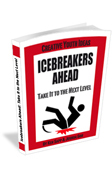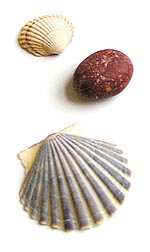Group Size: 10 to 30
Time: 20-60 minutes
Applications: Trust, Communication, Frustration, Blame, Focus, Shared Vision, Problem-solving, Commitment/Effort, Compensating for Differences
Materials
The filled stick (Really, just an ordinary 8 foot long light tent pole.)
Summary
The stick is very common team building game but one which proves difficult even if one or more participants have done it before. The stick seems to defy the laws of gravity and takes an incredible amount of well-coordinated teamwork to be successful. The basic idea is incredibly simple – lower a slim, wooden dowel to the ground all together as a team, but just as incredibly difficult to achieve. The stick rises into the air instead of getting lowered to the ground. How can that be? The team must work it out and find the solution.
Objective
Lower a thin stick to the ground as a group while everyone mains contact with their index fingers.
Instructions
1. “Form two lines facing each other and standing shoulder to shoulder.” (The lines must be close to each other –approximately 12 – 18 inches apart). 2. “Put your hands into a representation of a gun and down at your side.”
3. “On the count of 3– Quickdraw like a gunslinger from the American West!”
4. “1, 2, 3, DRAW”
5. “Good thing this isn’t the real west… I think you would have all killed each other!”
6. “Put both index fingers out zipper style (interlacing with your neighbor).”
7. Place the Stick – on top of the outstretched fingers. THIS PART IS IMPORTANT – when you place the tent pole on their fingers, do so from behind and in the middle of one of the lines ALWAYS KEEPING YOUR HAND ON TOP OF THE POLE to prevent the group from raising the pole in the air. Apply enough pressure on top of the pole to prevent the group from rising up.
8. While still holding it and putting a slight unnoticeable downward pressure, ask participants to “Please adjust your index fingers to roughly chest height so that all are touching the stick.”
9. “Your challenge is to lower the Stick to the ground. While doing so, each persons fingers must be in contact with the stick at all times.”
10. “No one may lose contact with the pole. If anyone loses contact with the stick the entire group must start again.”
11. “The starting position is with the pole at waist level.”
12. “You may not drop the pole”
13. “You must keep the sides of your index fingers touching at all times. Not the back, not your palms, and not hooking the pole with your finger. You cannot put your fingers on top of the stick. If one person’s finger comes off at any time, you start over.”
11. Release your pressure on the stick. Typically, the Stick will immediately start floating off!
12. Act surprised and ask them why they are raising the Stick instead of lowering it!
Facilitator Notes
1. When you place the stick on the group’s fingers, be sure to apply a slight downward pressure before letting them begin. This helps create the initial upward pressure that creates the ” stick.”
2. The Stick will continue to mysteriously have a habit of floating upwards rather than coming down. Often the more a group tries, the more it floats (as people get nervous their fingers jitter the Stick upwards). Participants may be confused initially about the paradoxical behavior of the Stick.
3. Its likely to take several attempts to just keep the tent pole steady (not lowering or raising).
4. Some groups or individuals (most often larger size groups) after 5 to 10 minutes of trying may be inclined to give up, believing it to be impossible. Suggest the group stop and discuss their strategy.
5. Eventually the group needs to calm down and very slowly, patiently lower the Stick.
6. If they get really frustrated, you can suggest they might want to stop and discuss what’s happening. You can either allow them to keep trying until they get it, or stop them when they’ve had enough. It’s a judgement call.
Safety Warning
The ends of the tent pole can be dangerous if the pole starts moving quickly
and hits someone in the face. Take precautions to prevent injury.
Variations
1. Add a washer to each end of the pole. Don’t drop the washer.
2. Have people pair up and supply each pair with a very short tent pole (18 inches). Have each pair lower their own pole to the ground so they can experience success. Then have people form groups of 4 and then provide them with a tent pole just long enough for 4 people. Have the groups of 4 work together to lower the pole. Continue making bigger groups until you have everyone working together on one tent pole.
Debrief
General Debrief
• “What happened?”
• “Why?”
• “What changed?”
• “So What?”
• “Now What?”
“What happened?”
1. What happened?
The results were initially the opposite of what was desired.
“Why?”
2. What factors limited your success?
(frustration, blame, gave up, lack of focus, lack of understanding the real problem, need for instant results, Failure to adjust to differences, Too many leaders,)
3. Did everyone understood the objective and the rules?
4. Was anyone intentionally trying to sabotage the group’s objective by lifting the stick?
5. Did everyone believe the task was acheivable?
6. Did everyone sincerely want to accomplish the objective?
7. If everyone understood the Objective, and was committed to succeeding, why did the group get so far off track right away? (didn’t plan well, over compensated, thought we were doing our part, etc)
8. What factors contributed to your eventual success?
(concentration, focus, patience, gentleness, adjusting to differences in height, strength, etc, unity – not trying to outdo others, communication, encouragement, perseverance, being able to deal with frustration, effective leadership)
“What Changed?”
9. What did you do to make your objective a reality?
(someone must take charge, discussion of strategy, more attentive to our position and differences and similarities related to those around us, clear communication, patience, keeping focused on the task, following the leader, manage frustration, play to group member strengths and compensate for weaknesses, share insights, cooperation, etc.)
“So What?”
10. Share some examples of groups that they have participated in “the real world” that seemed to be comprised of committed people, but were not achieving the results that everyone wanted? What insights might this game shed on those situations?
11. What are the possible applications of the lessons learned from this activity to business, personal development, spiritual life, and relationships?
KEY APPLICATION: When the best plans go awry.
Business
This activity mirrors the business dynamic of projects starting out well, but quickly going awry. Why is that? Sometimes the best laid plans just don’t work out. Having a clear vision is one thing but making it a reality is often another. The fact that everyone understood and was committed to the vision isn’t enough. It immediately went in the OPPOSITE direction from where you were trying to go – UP! Have you experienced any parallels to real life while doing this activity. What you do as a team when plans go awry has everything to do with team work, trust and communication.
Personal
Did you establish a plan early or simply react? Reacting without a plan can make the situation worse. What are some character attributes you would like to develop in your life? What are some bad traits that you would like to put down and suppress? Sometimes in trying to suppress things in our life we achieve the opposite effect. The key is to find balance and calm to deal with those things that lead us away from our goals. What are some frustrations that you have in life? How do you put aside the frustrations so that you can have the perseverance and calm to achieve your goals?
Spiritual
Sometimes when we spiritually strive to achieve spiritual fruit in our lives, we seem to get further away from where we want to be. The key is to rest and relax in the strength of God rather than trying to do things in our own strength. What are some areas of your life that you need to simply turn over to God and let him work them out? What are some areas where you are struggling and dealing with frustration and about to give up? How can you put them into God’s hands? Scripture is filled with paradoxes: The poor in Spirit shalln be Rich. The weak are strong. What are some spiritual paradoxes in your life?
Relationships
Do the results in your relationships sometimes seem to be opposite of what you desire? Do you have a tendency to take responsibility to work together to reduce the tension and work things back to a level of calm, or do you blame and do things that create more tension in relationships? What is your typical response when you feel others are to blame for the relationship not going the way you desire? Does this response help or hinder the relationship? If you are blamed, have fingers pointing at you, how do you feel? What is your typical response? (In the game, any tiny movement or even nervousness by one person causes jitters that eases the pole up, achieving the opposite result of what was wanted.) How can you bring calm and focus to your relationships? What feelings and emotions tend to rise up, even when you are trying to put them down? Are there times you feel like giving up? What is it that keeps you focused and committed in the relationship to see it through? For success in the game you had to compensate for individual differences (suck as height, strength, etc). How important is compensating for differences to success in relationships? How important is awareness of others? Are there times that you over compensate? If we know that everyone is committed to the objective, does it make it easier to handle things that seem to act contrary to our desire?
Now What?
12. What will you do differently as a result of this activity?

This 170 page resource not only provides 52 of the world’s most popular group icebreaker activities and games, but also includes lesson ideas and discussion questions to smoothly transition into conversations about the issues common to most groups.
Click here to find out how to get your hands on this incredible resource!

 Icebreakers Ahead: Take It To the Next Level
Icebreakers Ahead: Take It To the Next Level



 Materials
Materials